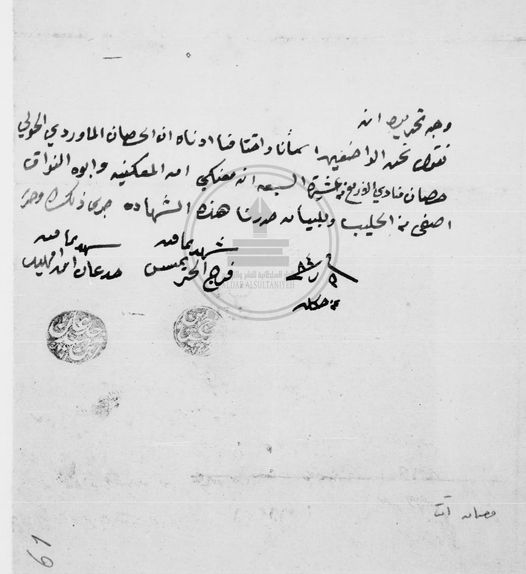Hujjah for a young horse from the Sba’ah, 1867-8

وضعت هذه الحجة عام ١٢٨٤ هجري الموافق ١٨٦٧-١٨٦٨ ميلادي لحصان عربي عمره سنة لونه ازرق ماوردي رسنه معنقي ابوه كحيلان نواق
مصدر الحجة أرشيف رئاسة وزراء السلطنة العثمانية بالاستانة عبر صفحة الدار السلطانية ومتصفح الوثائق العثمانية ويظهر فيها واحد من ختمين وصلانا من جدعان ابن مهيد عقيد عشيرة الفدعان من عنزه في ذاك الوقت كما يظهر فيها ختم فرج ابن حريميس شيخ العقاقرة من الفدعان
واليكم نص الحجة بالكامل
وجه تحريره انه
نقول نحن الواضعين اسمانا وأختامنا ادناه ان الحصان الماوردي الحولي حصان منادي الأزمع من عشيرة السبعة انه معنكي أمه المعنكية وأبوه النواق أصفى من الحليب وللبيان حررنا هذه الشهادة جرى ذلك وحرر
شهد بما فيه
جدعان بن امهيد
[ختم جدعان بن امهيد]
شهد بما فيه
فرج الحريميس
[ختم فرج الحريميس]
[الشهر غير مقروء] ١٢٨٤
[امضاء الكاتب غير مقروء]
This short hujjah from 1867-68 for a “rose water” (mawardi) grey yearling colt of the Ma’naqi strain comes from the archives of the Ottoman Grand Vizirate in Istanbul. The horse was probably a gift to the Ottoman Grand Vizir or someone associated with him. Here is my translation:
We who have put our names and seals on the below, declare that the rose-water yearling horse, the horse of Munadi al-Azma’ of the Sba’ah tribe, is a Ma’naqi, his dam is a Ma’naqiyah and his sire a Kuhaylan Nawwaq, he is purer than milk, and as evidence we have prepared this testimony
Faraj al-Huraymis
[seal of Faraj al-Huraymis]
Jad’aan Ibn Mhayd
[seal of Jad’aan Ibn Mhayd]
[illegible day and month] 1284
[illegible scribe’s signature]
This is a very simple North Arabian Bedouin hujjah, without any of the religious references or flowery language of the documents produced by townsfolk. It states the gender of the horse, his age, his coat color, his strain, his sire, his dam, his owner and his owner’s tribe. The phrase “purer than milk”, which also appears on some very similar hujaj for Davenport Arabians some forty years later signals authentic, purebred status.
The hujjah has the seal of Faraj Ibn Huraymis, the head of the ‘Aqaqirah tribal section of the Fad’aan tribe. It also features one of only two seals known for Jad’aan Ibn Mhayd, the ‘aqid or military leader of the Fad’aan and Sba’ah tribes at the time. Jad’aan already appeared in testimonies in the Abbas Pasha Manuscript (ca. 1850) and was active at the time of Lady Anne Blunt’s second desert journey (1881).
This document is special in that it is one of the earlier hujaj we have from the Anazah tribes. It predates the surviving hujjah of the Blunt mare Meshura (1881), which bears Jad’aan’s second known seal. It also predates the Ayerza (1898) and Davenport (1906) hujaj.
The phrase “purer than milk” is in that 1722 hujjah for Uxgate’s Ma’naqi as well, and also “pure que le lait” in the hujjah published by Rousseau in 1813 for the bay daughter of ibn Jadran’s Saqlawiyah. Nice to see it as a consistent descriptor in hujaj over the course of two hundred years.
very neat! Also note that “safi”, the word used for “pure”, is both literal (the milk is pure, ie no admixture of other ingredients like water) and figurative (the horse is pure, ie, no admixture of foreign blood).